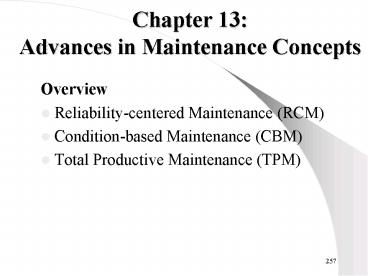Chapter 13: Advances in Maintenance Concepts - PowerPoint PPT Presentation
1 / 11
Title:
Chapter 13: Advances in Maintenance Concepts
Description:
Total Productive Maintenance (TPM) is a management approach to maintenance that ... TPM activities: Equipment operators 'autonomous maintenance' ... – PowerPoint PPT presentation
Number of Views:48
Avg rating:3.0/5.0
Title: Chapter 13: Advances in Maintenance Concepts
1
Chapter 13Advances in Maintenance Concepts
- Overview
- Reliability-centered Maintenance (RCM)
- Condition-based Maintenance (CBM)
- Total Productive Maintenance (TPM)
2
Time-based vs. Condition-based Maintenance
3
Reliability-Centered Maintenance
- Time-based overhauls of complex equipment reduce
a little frequency of failure and uneconomical - RCM is a logical methodology use the failure
mode effect and criticality analysis (FMECA)
tool for maintenance of complex equipment - Methodology
- Select the most important equipment systems
- Define the expected performance or function of
equipment? what constitutes a function failure
4
Reliability-Centered Maintenance
- Identify the root causes of the functional
failure - Determine the effect in a sequence of events in
terms of safety, production, environment, or a
hidden effect - Calculate the criticality of the effect of that
failure - Use RCM logic diagram to select the most
appropriate maintenance tactic to prevent the
failure - Determine the specific action to prevent
functional failure and its scheduling frequency - If no preventive task is appropriate, determine
whether it can be run to failure if a redesign is
warranted, or if there is a test to determine the
failure
5
Reliability-Centered Maintenance
- RCM ensures correct PM actions eliminate
inefficient PM - RCM outputs list of maintenance actions,
schedules, responsibilities - RCM favors condition-based maintenance
- Simplified RCM logic tree diagram
Combination? Redesign?
n
Is failure easy spotted?
Safety or Environmental Risk?
Defect a gradual loss of function?
Prevention through Scheduled overhauls/replacemen
t?
y
n
y
Nofailure finding test
No Production risk?
Yes condition-based maintenance
Yes Time-based maintenance
6
Condition-based Maintenance
- CBM uses condition data to determine more
precisely the most advantageous moment at which
to make a repair or replacement. - To implement CBM program we need to answer
- Why monitor?
- What equipment/component need to be monitored?
- What monitor technologies should be used?
- How should the monitoring be done?
- How often should the monitoring be done? When?
- How should the monitoring results be interpreted
and acted on? - Monitoring techniques Vibration Analysis, Oil
analysis, Ultrasonic, Penetrate, etc.
7
Condition-based Maintenance
- How to access the large volume of condition
data?? Proportional Hazards Modeling (PHM) the
sttistical technique connects condition data to
the corresponding failure age (EXAKT software) - The PHM process
- Prepare and study the data
- Estimate the parameters of the PHM model
- Testing how good the PHM model is
- Establish transition probability model states,
prob. - Test transition behavior assumptions in different
time intervals and interdependence of covariate
group - Making the optimal decision for lowest, long-run
maintenance cost DM parameters, cost function ?
optimal repair/replacement policy - Sensitivity analysis of the optimal policy
8
Total Productive Maintenance
- Total Productive Maintenance (TPM) is a
management approach to maintenance that focuses
on involving all employees in an organization in
equipment improvement - Objectives
- Maximize overall equipment effectiveness
availability, process efficiency, and product
quality - Take a systematic approach to reliability,
maintainability, life cycle costs - Involve operations, material management,
maintenance, engineering, an administration in
equipment management
9
Total Productive Maintenance
- Involve all levels of management and workers
- Improve equipment performance through small group
activities and team performance - TPM activities Equipment operators ? autonomous
maintenance - Employee empowerment operations ?maintenance
skill transfer - Equipment management identify major losses
- Breakdowns, setup and adjustment downtime ?
Availability - Idling and minor stoppages, reduced speed ?
Efficiency - Process defects, reduced yield ? Product quality
10
Total Productive Maintenance
- TPM performance measureOEEavailability
performance efficiency quality rate - Availability (loading timedowntime)/loading
time) - Performance efficiency (theoretical cycle time
amount processed)/operating time - Quality rate (amount processed defective
amount) amount processed - OEE (theoretical cycle timeamount
processedquality rate)/loading time
11
Total Productive Maintenance
- Steps for implement TPM
- Decision to introduce TPM
- Launch an educational campaign to introduce TPM
- Create organizational to promote TPM
- Establish basic TPM policies
- Formulate a master plan for TPM development
- Hold TPM kick-off
- Improve effectiveness of each equipment
- Develop an autonomous maintenance program
- Develop a scheduled maintenance program
- Conduct training to improve operation and
maintenance skills - Develop an effective management program
- Perfect TPM implementation and raise TPM levels































